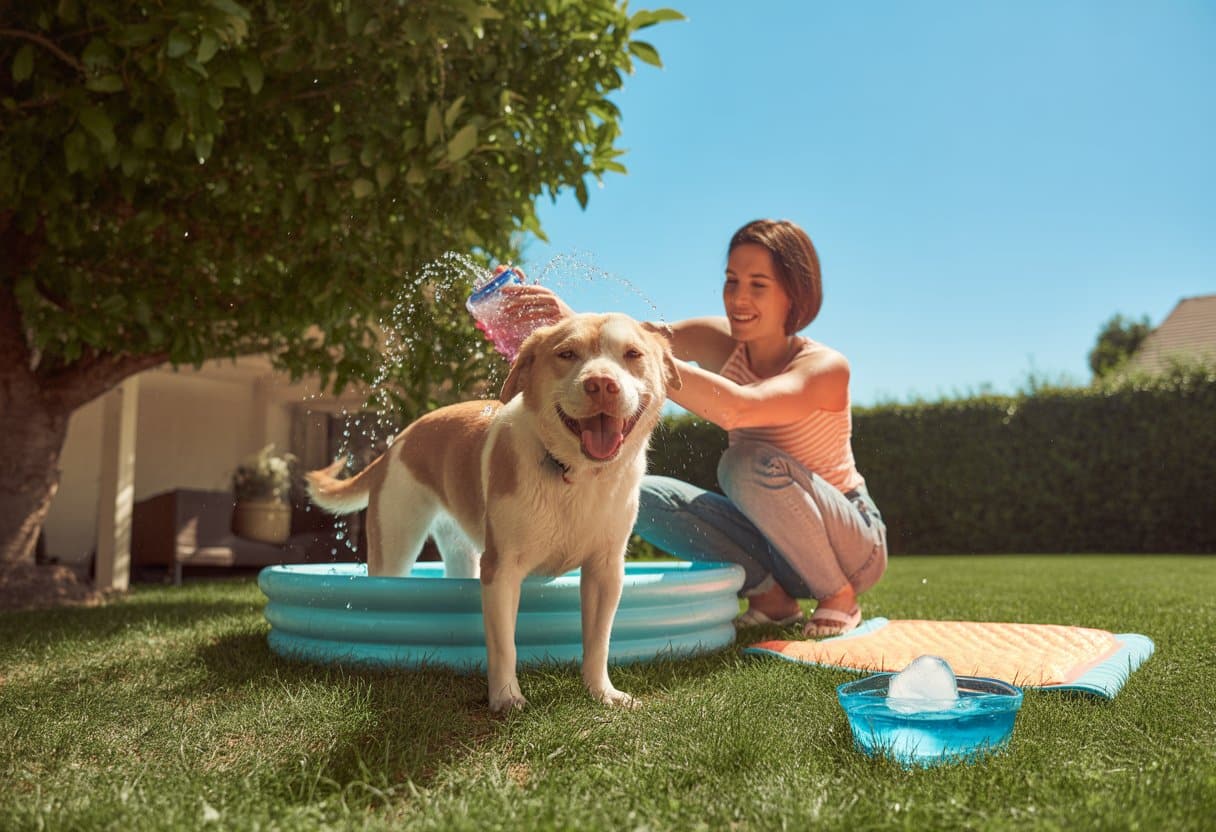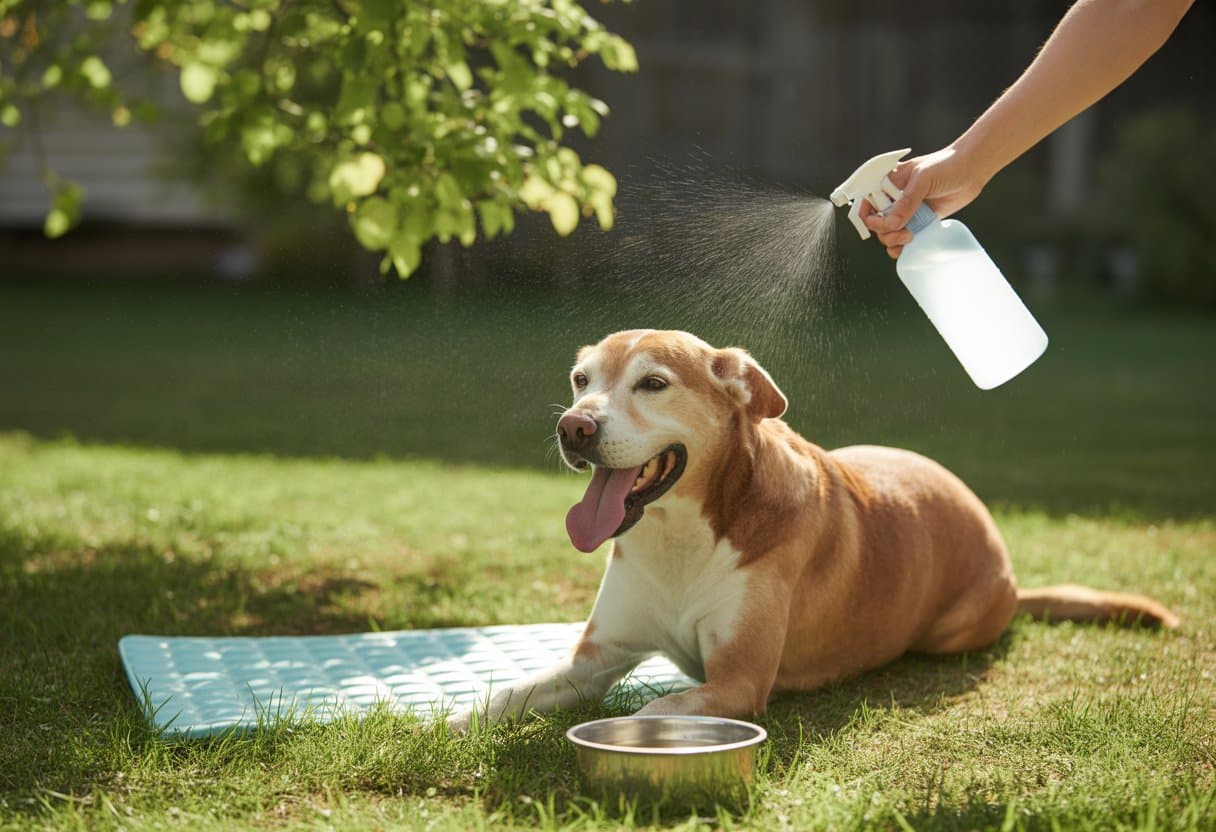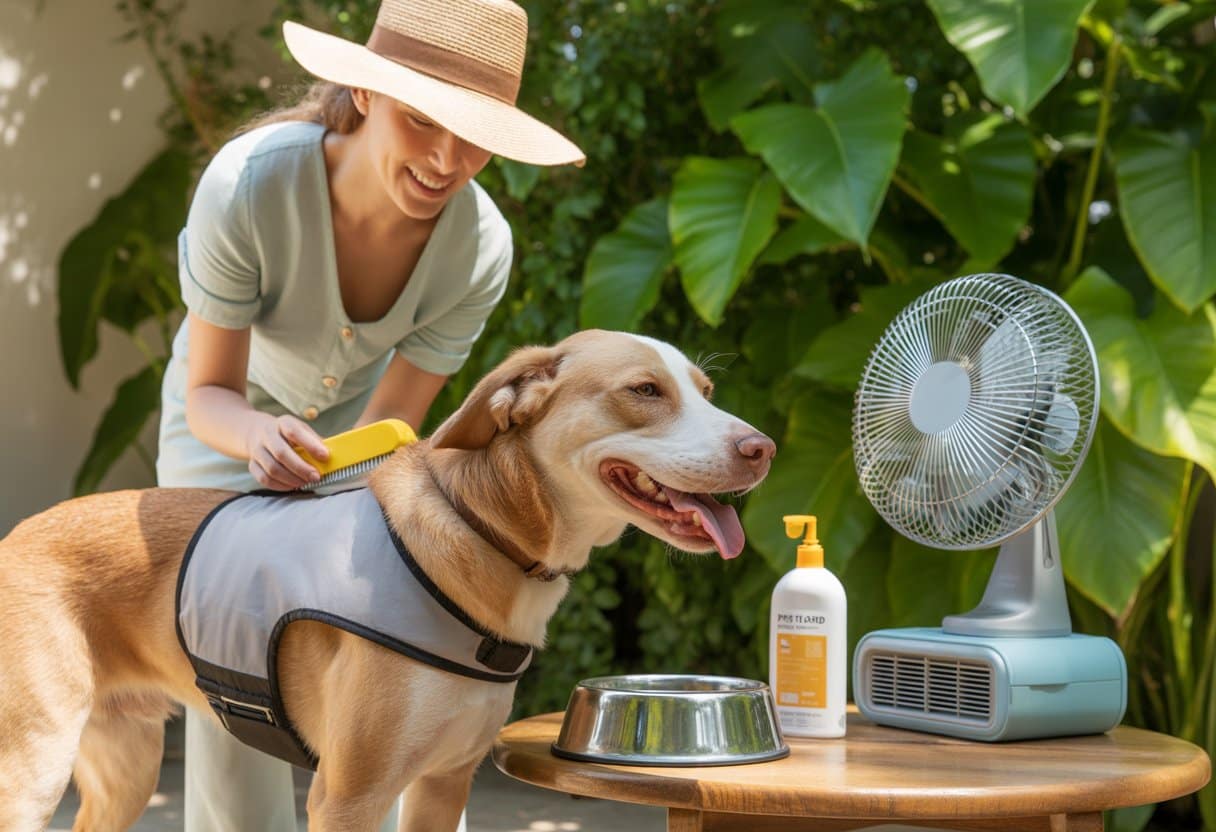
When temperatures soar during a heatwave, dogs face serious health risks because they cannot regulate their body temperature as effectively as humans.
Unlike people who can sweat through their skin, dogs rely mainly on panting and releasing heat through their paw pads to stay cool.
This makes them particularly vulnerable to overheating and potentially life-threatening heatstroke.
The most effective ways to keep dogs cool include providing constant access to fresh water, creating shaded areas, using cooling mats or vests, and adjusting exercise routines to cooler parts of the day.
Pet owners can also use techniques like wet towels on the dog’s underbelly and footbaths with cool water to help lower their dog’s body temperature safely.
Understanding the warning signs of overheating and knowing how to respond quickly can make the difference between a minor heat-related issue and a veterinary emergency.
Key Takeaways
- Dogs are at high risk during heatwaves because they cannot sweat and rely on panting to cool down
- Fresh water, shade, cooling products, and modified exercise schedules are essential for preventing overheating
- Recognizing early signs of heat stress and knowing emergency cooling techniques can save a dog’s life
Understanding Heatwaves and Your Dog’s Risks

Dogs face serious health risks during heatwaves because they cannot cool themselves as effectively as humans.
Certain breeds and health conditions make some dogs more vulnerable to heat-related illness than others.
How Dogs Regulate Body Temperature
Dogs have a very different cooling system than humans.
They cannot sweat through their skin like people do.
Most of a dog’s sweat glands are found on their footpads.
This means sweating provides very little cooling for their whole body.
Dogs rely mainly on panting to cool down.
When they pant, air moves over their tongue and mouth. This helps water evaporate and removes heat from their body.
Primary cooling methods for dogs:
- Panting through mouth and tongue
- Limited sweating through paw pads
- Seeking cool surfaces to lie on
Panting is much less efficient than human sweating.
During heatwaves, this limited cooling system can quickly become overwhelmed.
The process becomes even less effective in humid weather.
High humidity makes it harder for water to evaporate from their tongue and breathing passages.
Heatstroke in Dogs: Causes and Dangers
Heatstroke happens when a dog’s body temperature rises to dangerous levels.
Normal body temperature for dogs ranges from 101-102.5°F.
Dogs and cats are more sensitive to heat than many people realize and can easily overheat during summer heatwaves.
Body temperatures above 106°F can cause serious organ damage.
Common causes of heatstroke in dogs:
- Being left in hot cars
- Exercising during peak heat hours
- Lack of shade or water access
- Hot pavement burning paw pads
Heatstroke can cause multiple organ damage and can be fatal if not treated promptly.
The condition affects the brain, kidneys, liver, and heart.
Early warning signs include heavy panting, drooling, and seeking cool surfaces.
More serious symptoms include vomiting, diarrhea, confusion, and collapse.
Breeds and Factors That Increase Vulnerability
Dogs with shorter noses and flatter faces are more prone to overheating.
These breeds have smaller airways that make panting less effective.
High-risk breeds include:
- Bulldogs
- Pugs
- Boston Terriers
- Shih Tzus
- Pekingese
Arctic dog breeds can also become overheated during the warmer months.
Breeds like Huskies and Malamutes have thick coats designed for cold weather.
Additional risk factors:
- Overweight dogs – Extra weight makes cooling harder
- Pregnant animals – Higher metabolic demands
- Senior dogs – Reduced ability to regulate temperature
- Dogs with heart or breathing problems – Compromised cooling systems
Young puppies also face higher risks because their temperature regulation systems are not fully developed.
Identifying Signs of Overheating
Dogs show clear warning signs before overheating becomes dangerous.
Recognizing these symptoms early can prevent serious health problems and save a dog’s life.
Early Warning Symptoms
Dogs display several subtle signs when they first start getting too hot.
Panting is normal for dogs, but excessive panting signals the beginning of overheating.
Physical behaviors include seeking shade or lying on cool surfaces like tile floors.
Dogs may also show increased drinking and wet footprints from sweating through their paw pads.
Behavioral changes become noticeable too.
The dog might seem restless or agitated. Some dogs become unusually quiet or lethargic instead.
Key early warning signs:
- Heavy panting with tongue hanging out
- Drooling more than usual
- Seeking cool spots constantly
- Drinking water excessively
- Restlessness or lethargy
These symptoms mean the dog needs immediate cooling measures.
Moving to air conditioning and offering water can prevent progression to more serious problems.
Advanced Signs of Heatstroke
Heatstroke in dogs develops when early warning signs go unaddressed.
The dog’s body temperature rises dangerously high, causing multiple organ problems.
Breathing difficulties become severe.
The dog pants heavily but cannot cool down effectively. Their breathing may sound labored or distressed.
Physical symptoms worsen rapidly. The dog’s gums turn bright red or brick-colored instead of normal pink.
Vomiting and diarrhea often occur together.
Serious heatstroke symptoms:
- Brick-red or purple gums
- Difficulty breathing
- Vomiting and diarrhea
- Confusion or disorientation
- Weakness or collapse
- Seizures
The dog may stumble or seem confused.
In severe cases, they collapse completely or have seizures. These signs require emergency veterinary treatment immediately.
When to Seek Veterinary Help
Emergency veterinary attention becomes necessary when dogs show any advanced overheating symptoms.
Waiting can result in permanent organ damage or death.
Immediate veterinary care is needed for brick-red gums, vomiting, difficulty breathing, or collapse.
These symptoms indicate the dog’s organs are failing from excessive heat.
Call the veterinarian before traveling.
Describe the symptoms clearly so they can prepare for treatment. Keep the car cool during transport with air conditioning running.
Emergency situations requiring immediate vet care:
- Gum color changes to red or purple
- Vomiting or diarrhea
- Difficulty breathing or gasping
- Weakness or collapse
- Seizures or tremors
- Confusion or disorientation
Even dogs that seem to recover need veterinary evaluation.
Heatstroke can cause organ damage that appears hours later.
Professional assessment ensures no hidden complications develop.
Creating a Cool Environment Indoors and Outdoors
Dogs need specific cooling zones and proper ventilation to survive heatwaves safely.
The right combination of indoor setups, outdoor shade, and cooling products can prevent dangerous overheating.
Setting Up Cooling Zones in the Home
The basement offers the coolest natural space in most homes during heatwaves. Dogs can retreat to this area when temperatures rise dangerously high.
Battery-operated fans provide essential air circulation when power goes out. Position fans at floor level where dogs spend most of their time.
Cooling crate pads and cold, wet towels create comfortable resting spots. Dogs can lie on these surfaces to release body heat through contact cooling.
Ventilation is critical for indoor cooling zones. Open windows on opposite sides of rooms to create cross-breezes.
Close curtains during peak sun hours to block heat.
Tile and hardwood floors stay cooler than carpet. Encourage dogs to rest on these surfaces by placing their beds nearby.
Safe Outdoor Spaces and Shade Solutions
Natural shade from trees provides the best outdoor cooling. The ground under trees stays significantly cooler than open areas.
Covered patios and awnings block direct sunlight while allowing air circulation.
These spaces work better than enclosed structures that trap heat.
Timing matters for outdoor access. Early morning and late evening offer the safest temperatures for dogs during heatwaves.
Kiddie pools filled with cool water let dogs cool their paws and bodies. Change the water regularly to prevent bacteria growth.
Avoid hot surfaces like concrete and asphalt. These materials burn paw pads and reflect heat upward.
Grass and dirt stay cooler throughout the day.
Portable shade structures work when natural shade is unavailable. Set these up in yards or camping areas to create instant cooling zones.
Choosing the Best Cooling Products
Cooling vests use evaporation to lower body temperature. These vests deflect heat while providing continuous cooling through moisture.
Cooling cloths stored in coolers provide quick relief. Never place cloths directly on ice, as extreme cold shrinks blood vessels and creates more internal heat.
Spray bottles filled with cool water target specific body areas. Focus on the groin, paw pads, and inside the mouth where hair is less dense.
Elevated beds improve air circulation around resting dogs. Metal frame beds work better than solid surfaces for cooling.
Cooling mats contain gel that stays cool without electricity. These mats activate when dogs lie down and provide hours of cooling relief.
Water bowls with ice cubes encourage hydration. Replace ice regularly and provide multiple water stations throughout the home.
Managing Water, Hydration, and Treats
Water becomes critical during hot weather as dogs lose fluids through panting and need constant access to fresh water to regulate body temperature.
Frozen treats provide both hydration and cooling relief while proper hydration strategies during outdoor activities prevent dangerous overheating.
Ensuring Constant Access to Drinking Water
Dogs need fresh water available at all times during hot weather. Their water bowls should be refilled multiple times daily as warm temperatures cause water to evaporate quickly and become less appealing to drink.
Keeping water cool outdoors requires strategic placement and proper equipment. Place water bowls in shaded areas away from direct sunlight.
Insulated water bowls maintain cooler temperatures longer than regular bowls.
Adding ice cubes to water bowls provides immediate cooling. However, some dogs avoid very cold water, so owners should monitor their pet’s drinking habits.
Indoor water stations should be placed in multiple locations throughout the house. This ensures dogs can access water without walking long distances during hot days.
Outdoor water solutions include:
- Elevated bowls to reduce ground heat transfer
- Automatic water dispensers that refill continuously
- Multiple water stations around the yard
- Ceramic or stainless steel bowls instead of plastic
Making Homemade Frozen Treats
Frozen dog treats provide cooling relief while encouraging hydration. These treats help lower body temperature from the inside while keeping dogs entertained during hot weather.
Simple frozen treats can be made using ice cube trays or popsicle molds. Fill trays with water, low-sodium broth, or diluted unsweetened fruit juices safe for dogs.
Basic frozen treat recipes:
- Water and broth pops: Mix equal parts water and low-sodium chicken broth
- Fruit ice cubes: Freeze small pieces of watermelon, blueberries, or apple slices in water
- Yogurt treats: Use plain, unsweetened yogurt mixed with water
Kong toys filled with wet food or treats and frozen create longer-lasting cooling entertainment.
This method combines hydration with mental stimulation.
Avoid ingredients toxic to dogs including chocolate, grapes, onions, or artificial sweeteners. Always use dog-safe ingredients and introduce new treats gradually.
Hydration Tips for Walks and Travel
Proper hydration during walks prevents heat exhaustion and keeps dogs comfortable during necessary outdoor activities.
Timing and preparation become essential for safe summer exercise.
Walk during cooler hours, typically early morning or evening when temperatures drop. Carry portable water bowls and bring more water than expected needs.
Essential walking supplies:
- Collapsible water bowl
- Insulated water bottle
- Cooling towel for emergencies
- Portable shade umbrella
During car travel, never leave dogs unattended in vehicles.
Bring multiple water bottles and plan stops every 30-60 minutes for hydration breaks.
Travel hydration checklist:
- Pack extra water for unexpected delays
- Bring familiar water bowls to encourage drinking
- Monitor panting levels throughout the journey
- Keep air conditioning running consistently
Signs of dehydration include excessive panting, lethargy, and sticky gums.
If these symptoms appear, offer water immediately and seek shade or air conditioning.
Adjusting Routines: Exercise, Grooming, and Sun Protection

Simple changes to daily routines can protect dogs from heat-related health problems during extreme temperatures.
Proper timing of walks and grooming practices work together with sun protection to keep pets safe.
Safe Exercise During High Temperatures
Exercise routines must be adjusted during heatwaves to prevent overheating.
The safest times for walks are early morning or late evening when temperatures drop.
Best Exercise Times:
- Early morning: 6:00 AM – 8:00 AM
- Late evening: 7:00 PM – 9:00 PM
- Avoid: 10:00 AM – 6:00 PM
Hot pavement burns paw pads quickly. Test surfaces with your hand for five seconds before walking dogs on them.
Activities should be lighter during heat waves. Replace long runs with short walks and frequent breaks in shaded areas.
Indoor exercise becomes important when outdoor temperatures exceed 80°F. Mental stimulation through puzzle toys can replace physical activity safely.
Proper Grooming and Coat Care in Summer
Regular grooming removes loose fur and prevents matting that traps heat against the skin.
Brushing should happen daily during hot weather.
Grooming Benefits:
- Removes dead undercoat
- Improves air circulation
- Prevents heat-trapping mats
- Allows better cooling through panting
Trimming long fur helps dogs stay cooler. However, complete shaving removes natural sun protection and should be avoided.
Bathing provides immediate cooling relief. Cool water works better than cold water, which can shock the system.
Certain breeds need extra attention.
Dogs with thick double coats like Golden Retrievers benefit from more frequent brushing sessions.
Using Pet-Safe Sunscreen for Sunburn Prevention
Dogs need pet-safe sunscreen on exposed skin areas. Human sunscreen contains zinc oxide and other chemicals that are toxic to dogs.
Areas needing protection:
- Nose and muzzle
- Ear tips
- Belly (thin-haired areas)
- Inner thighs
Dogs with light-colored fur or thin coats face higher sunburn risks. White dogs and those with pink skin are most vulnerable.
Apply sunscreen 15 minutes before going outside. Reapply every 2-3 hours during extended outdoor time.
Look for sunscreens made specifically for pets. These products avoid harmful ingredients while providing SPF protection.
Never use products containing zinc oxide, PABA, or fragrances on dogs. These ingredients can cause poisoning if licked off.
Emergency Cooling Techniques and First Aid
Quick action can save a dog’s life when heatstroke strikes. The first few minutes are critical for lowering body temperature and preventing permanent damage.
Immediate Actions for Overheated Dogs
Move the dog to a cool, shaded area immediately. If indoors, place them near a fan or air conditioning unit.
Remove them from hot surfaces like concrete or asphalt.
Check for signs of overheating including excessive panting, drooling, and bright red gums.
Rapid heart rate and lethargy are also warning signs.
Offer small amounts of cool water frequently. Never force water into the dog’s mouth.
This can cause choking or vomiting.
Apply cool, wet towels to areas with less fur. Focus on the neck, armpits, and groin where blood circulation is better.
Replace towels as they warm up.
Never use ice or very cold water. This causes blood vessels to narrow and traps heat inside the body.
Place the dog’s paws in cool water. This helps lower their body temperature gradually.
Keep the water at room temperature, not cold.
Cooling Tools and DIY Solutions
Wet towels work faster than dry cooling methods. Soak towels in cool water and apply them to key areas.
Change them every few minutes.
A fan enhances cooling by moving air across wet fur. Point it directly at the dog for maximum effect.
Combine this with wet towels for better results.
Cooling mat alternatives:
- Wet blankets on tile floors
- Damp towels in the refrigerator (not freezer)
- Cool water in a kiddie pool for larger dogs
A garden hose can provide gentle cooling. Use a light spray on the belly and paws.
Avoid high pressure that might stress the dog.
Aftercare Following a Heat Incident
Monitor the dog’s temperature if possible. Normal body temperature ranges from 100.5°F to 102.5°F.
Continue cooling until temperature drops to safe levels.
Watch for delayed symptoms even after the dog seems better. Internal damage from heatstroke might not show immediately.
Keep the dog calm and quiet.
Contact a veterinarian immediately even if the dog appears to recover. Heatstroke can cause internal damage that requires professional treatment.
Provide a quiet, comfortable recovery area. Limit activity and stress during the recovery period.
Fresh water should remain available at all times.
Frequently Asked Questions
Dog owners often need quick solutions for cooling their pets during extreme heat. Indoor cooling methods, temperature reduction techniques, and safety measures can help prevent heat-related health issues in dogs.
What are effective methods to cool down a dog indoors without air conditioning?
Wet towels provide one of the most effective cooling methods. Pet owners should soak towels in cool water and place them on the dog’s underbelly to target the femoral artery for faster cooling.
Fans create helpful air circulation when used properly. The fan should never point directly at the dog’s face during panting, as this can cause complications from excessive air consumption.
Cool surfaces offer natural temperature relief. Dogs benefit from lying on tile, marble, or wooden floors instead of carpet, which traps heat.
A cool shower helps reduce body temperature quickly. Tepid water works best, as cold water can shock the dog’s system and cause dangerous complications.
How can you reduce a dog’s body temperature when it’s panting excessively?
Fresh water should be available at all times. Providing an ongoing supply of cool water helps dogs regulate their body temperature more effectively through hydration.
A footbath offers immediate cooling relief. Fill a large tub with cool water and have the dog stand in it, allowing the paws to absorb the cooler temperature.
Moving to a cooler environment helps reduce strain on the dog’s cooling system. Basements and lower levels of homes stay naturally cooler than upper floors.
What precautions can be taken to ensure a dog stays cool while the owner is at work?
Air conditioning should remain on during hot days. Dogs need access to cool environments with frequent access to fresh water throughout the day.
Cooling mats provide continuous temperature relief. These products work without electricity and offer a cool surface for dogs to rest on during the day.
Window coverings help maintain indoor temperatures. Curtains and blinds should be closed to block direct sunlight and reduce heat buildup in the home.
How can a dog be kept comfortable and cool during nighttime in a heatwave?
Cool sleeping surfaces work better than soft bedding. Dogs should sleep on tile or wooden floors rather than thick beds that trap body heat.
Fans can run safely overnight when positioned correctly. The airflow should circulate around the room rather than blow directly on the sleeping dog.
Frozen treats before bedtime help lower body temperature. These can be prepared in advance and given as the dog settles down for the night.
Are there any techniques to safely cool a dog that appears overheated?
Temperature monitoring becomes critical for overheated dogs. Normal body temperature should be 102 degrees Fahrenheit, while overheating occurs above 103 degrees.
Wet towels on the underbelly and inner thighs provide targeted cooling for major blood vessels. Kitchen towels work best because they are thinner and transfer coolness more effectively.
Veterinary attention may be necessary if cooling methods don’t work. Dogs showing signs of heatstroke need immediate professional medical care.
What are the signs that the weather is too extreme for a dog’s safety outdoors?
Early morning and evening hours are safer for outdoor activities than midday heat.
The hottest part of the day should be avoided completely.
Pavement temperature can burn dog paws.
If the ground feels too hot for human hands, it’s too hot for dogs to walk on safely.
Excessive panting, bright red gums, and lethargy indicate heat stress.
These symptoms mean the dog should return indoors immediately and begin cooling procedures.




